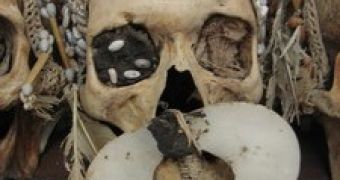300 years before the rise of the Inca empire, the Wari civilization vanished.
Their empire lasted from 500 to 1200 A.D.
But now archaeologists and Earthwatch volunteers led by Dr. Mary Glowacki and Louis Tesar dug up in 2006 an elite Wari cemetery at Cotocotuyoc, Huaro Valley, near Cuzco, Peru.
The most important discovery till now seems to be that of a "trophy skull," a clue about the warfare in Wari Empire. The cranium was found under a special pattern llama bones placement.
A large circular hole cut in the skull's base suggests that it may have been put or held on a pole, while another one in its back points that it may have been worn as a large pendant, perhaps during special ceremonies.
The scalp was removed, as a cut on the frontal bone indicates. It was later reattached to the skull with gold alloy pins. The archaeologists believe the cranium belonged to a 30 years warrior, as many healed scars and abrasions were observed on its surface, and could have been a prestigious one if his skull was displayed in rites. "The trophy skull adds a new dimension to our understanding of the role of warriors and warfare in Wari culture," says Glowacki. "I hope to be able to find the edges of the cemetery. We think we know where the center is, but don't know how far it goes," says Glowacki.
The diggings also showed up whole ceramic pots inside the women's tombs.
By now, just one man was discovered in the cemetery, suspected to have been a guardian as his remains present many wounds and his tomb was built into the cemetery wall. Some pots presented painted owls as decorations, the birds being an alter ego of female shamans in ancient Peru.
This cemetery proves an early Wari existence in the area, being in the end the last Wari stronghold after their Empire's collapse and total disappearance.

 14 DAY TRIAL //
14 DAY TRIAL //